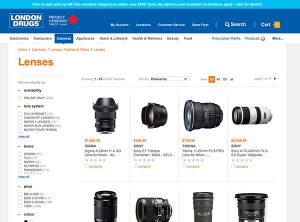
How many different lenses are available at londondrugs.com? Oh, probably a million or so. If the selection seems overwhelming, there is a cure: speak to a London Drugs camera expert in-store.
We’ve been talking quite a bit about enlargements here on the Photoblog. The fact is, however, that if you aren’t shooting with enlargements (or fine art prints or gallery wraps for that matter) in mind, you’re simply not going to have a great range of options. If you’re even thinking of printing an enlargement or two (and I strongly recommend doing so as a centerpiece for at least one of your walls) your photos will definitely need to be high-resolution. Fortunately, when you order prints of any size through the Photolab, the web app will indicate if your image file is too low-res and thus the print quality will be compromised as a result.
Composition is also critical when you’re looking at enlargements—and of course, the lens you choose will have a huge impact on your composition. There are a number of informative past Photoblog posts on the subject of lenses, such as these:
Certainly, you’ll find no shortage of options when it comes to adding to (or beginning) your lens collection. Yet for the purposes of this post let’s look at two common lens options—telephoto and wide angle.
Telephoto zoom lens
Laypeople and casual photographers tend to associate zoom lenses with tiger safaris and other hardcore photo expeditions; while they’re definitely appropriate in such scenarios, zoom lenses have many everyday applications as well. As noted in this post, they’re also a great way to capture amazing action shots of the kids in a state of play, uninhibited by the presence of a camera in their faces (just make sure they’re your kids of course!) Keep some standard composition techniques for zoom lenses in mind (such as those listed here) and they’ll be sure to translate into stunning enlargements to hang on your wall.
Wide angle
If ever there was a lens created just for enlargements, it would have to be the wide angle lens. Sweeping panoramas, breathtaking scenery, group photos at supersized family reunions…the wide angle is your go-to. However, don’t think you’re limited to horizontal landscapes; as this post points out, turning a wide angle lens on its side—thereby creating a ‘vertical landscape’—distorts proportion and makes items in the foreground appear larger and more imposing while making the background and horizon seem to go on forever. Imagine the impact of three vertical landscape shots printed as enlargements and hung on your wall as a tryptich (aka the term for a panel of three images displayed together).
If you’re looking to explore the world of lenses, your best option is to start by speaking with an expert at your local London Drugs camera department, who can recommend the best lens options for you based on the type of photography you’re most interested in doing—which, of course, should be based on the type of photos you’d like to see hanging on your walls.

